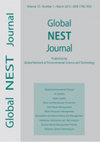Heavy metals uptake by hyperaccumulating flora in some serpentine soils of Kosovo
IF 1.2
4区 环境科学与生态学
Q4 ENVIRONMENTAL SCIENCES
引用次数: 15
Abstract
Ultramafics represent magmatic or metamorphic rocks which are characterized by high concentrations of Mg, Fe, Ni, Cr and Co and low concentrations of Ca, and K. Serpentine soils are weathered products of a range of ultramafic rocks composed of ferromagnesian silicates. The aim of this study was to determine the content of heavy metals in some of serpentine soils of Kosovo and heavy metals uptake by entire associated flora. Furthermore, another objective of this study was finding out bioavailable Ca/Mg relationship, which is very important indicator for plants' development. The sampling was conducted in June 2014. A total of three serpentine areas have been surveyed and 7 soil samples have been taken in various depths of soil profiles. Those samples were analyzed for total Ca, Cd, Co, Cr, Cu, Mn, Ni, Pb, Fe and Zn. Results showed that each site exhibited a high concentration of at least one metal. The maximum concentrations of metals in soils Dry Matter (DM) were 108.9 mg kg(-1) Cd, 95.8 mg kg(-1) Co, 1206 mg kg(-1) Cr, 24 mg kg(-1) Cu, 2570 mg kg(-1) Ni, 21.7 mg kg(-1) Pb, 39 mg kg(-1) Zn, and 51563 mg kg-Fe. The serpentine soils at all sites were characterized by elevated levels of heavy metals, which showed typical properties of ultramafic environments. Nickel Total at studied areas varied between 1543 and 2570 mg kg(-1), while the highest Ni concentration was found in aerial part of Alyssum markgrafii (4038 mgkg(-1)), Based on our findings on the field we concluded that there is a close relationship between the quantity of Ni in soil and Ni uptake in plants.科索沃蛇形土壤中超富集植物群对重金属的吸收
超镁铁质是一种岩浆或变质岩,其特征是镁、铁、镍、铬、钴含量高,钙、钾含量低。蛇纹石土壤是一系列由镁铁硅酸盐组成的超镁铁质岩石的风化产物。本研究的目的是确定科索沃一些蛇纹石土壤中的重金属含量以及整个相关植物群对重金属的吸收。此外,本研究的另一个目的是发现生物可利用钙/镁的关系,这是植物发育的一个重要指标。抽样于2014年6月进行。共调查了3个蛇纹石区,并在土壤剖面的不同深度采集了7个土壤样品。分析了这些样品中Ca、Cd、Co、Cr、Cu、Mn、Ni、Pb、Fe和Zn的总量。结果表明,每个位点至少含有一种高浓度的金属。土壤干物质(DM)中金属的最大浓度分别为Cd 108.9 mg kg(-1)、Co 95.8 mg kg(-1)、Cr 1206 mg kg(-1)、Cu 24 mg kg(-1)、Ni 2570 mg kg(-1)、Pb 21.7 mg kg(-1)、Zn 39 mg kg(-1)和fe 51563 mg kg -1。所有站点的蛇纹石土壤重金属含量均有所升高,表现出典型的超镁铁环境特征。研究区镍总含量在1543 ~ 2570 mgkg(-1)之间,其中地上部分的镍含量最高(4038 mgkg(-1))。根据田间研究结果,我们认为土壤中镍的含量与植物对镍的吸收有密切关系。
本文章由计算机程序翻译,如有差异,请以英文原文为准。
求助全文
约1分钟内获得全文
求助全文
来源期刊

Global Nest Journal
环境科学-环境科学
CiteScore
1.50
自引率
9.10%
发文量
100
审稿时长
>12 weeks
期刊介绍:
Global Network of Environmental Science and Technology Journal (Global NEST Journal) is a scientific source of information for professionals in a wide range of environmental disciplines. The Journal is published both in print and online.
Global NEST Journal constitutes an international effort of scientists, technologists, engineers and other interested groups involved in all scientific and technological aspects of the environment, as well, as in application techniques aiming at the development of sustainable solutions. Its main target is to support and assist the dissemination of information regarding the most contemporary methods for improving quality of life through the development and application of technologies and policies friendly to the environment
 求助内容:
求助内容: 应助结果提醒方式:
应助结果提醒方式:


